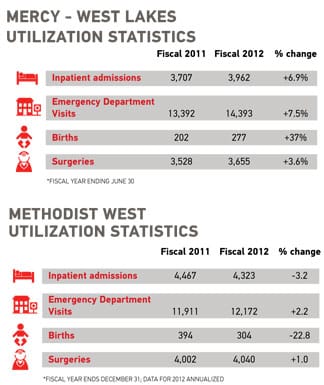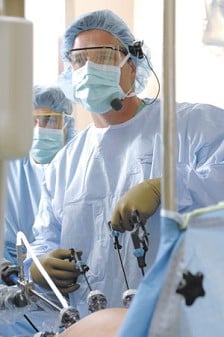A tale of two hospitals
Three years after Methodist West and Mercy - West Lakes opened amid a bit of opposition, officials say they are meeting usage projections

To a casual observer, the partially filled parking lot and quiet hallways at Mercy – West Lakes Hospital might suggest that the West Des Moines hospital isn’t all that busy.
On many days, the casual observer would be wrong, says Laurie Conner, West Lakes’ administrator.
“We’re hovering right around full, but when you walk around the halls, you might not think that,” she said. She credits the hospital’s patient-centered design elements as well as underground parking used by much of the staff and visitors for giving that perception.
“Our goal is to have a very serene, quiet healing environment.”

Just more than three years after Mercy opened 82-bed West Lakes Hospital and Iowa Health opened 83-bed Methodist West Hospital, the two new West Des Moines hospitals have seen steady growth in usage, say their respective administrators.
Opened within six weeks of each other in the fall of 2009, the two hospitals annually are providing care for tens of thousands of patients annually.
“We’ve continued to enjoy that slow but steady growth, which is exactly what we wanted,” Methodist West Administrator Chris Blair said. “It’s much easier to manage that.”
Closer to home
Blair, who reads every patient survey that’s completed, said she frequently sees comments along the lines of, “I’m glad that this hospital is here.”
“That’s probably what I see most often for the emergency department,” she said. “We see a lot of comments about it being closer to home or the fact they don’t have to drive downtown.”
Methodist West’s emergency department expects to surpass 12,000 visits by the end of the year, up from just more than 11,000 visits in its first full year of operations in 2010. At the present pace, the department’s number of visits will be up 2.2 percent at the end of the year compared with 2011.
“What’s interesting is that we thought we would off-load some of the backlog (for the emergency department) downtown, but what we have seen is an overall growth in emergency volume,” she said. “It seemed like every weekend this summer our emergency department had a new record high in visits.”
Mercy’s emergency department at West Lakes had nearly 14,400 visits in its past fiscal year that ended Sept. 30, a 7.5 percent increase from the previous fiscal year.
Inpatient admissions at West Lakes increased by 2 percent in the first half of the year; total admissions in the fiscal year that ended June 30 surpassed 4,000 patients. Methodist West, for the calendar year ending Dec. 31, projects 4,323 inpatient admissions, a 2.3 percent decrease from 2011.
Statewide, inpatient hospitalizations have been decreasing, which mirrors a national trend toward fewer admissions because the number of procedures that can be performed on an outpatient basis is increasing. 
Early opposition
Mercy Medical Center officials designed the West Lakes hospital to replace Mercy – Capitol, which Mercy closed when it opened the new hospital. As a replacement hospital, West Lakes wasn’t subject to the Iowa Department of Public Health’s “certificate of need” review process, as Iowa Health’s new hospital was.
Iowa Health had long pursued a West Des Moines hospital. In February 2004, the Iowa Health Facilities Council rejected an initial certificate of need application by the hospital group, saying another hospital was not needed. Two years later, Iowa Health applied again and received approval.
Another hurdle was opposition by Wellmark Blue Cross and Blue Shield, which argued opening two new hospitals would result in a duplication of services that would result in higher health-care costs. After much legal wrangling, in October 2007, Iowa Health reached a 10-year agreement with Wellmark in which the hospital group agreed to reduce the number of beds with which the facility would open and Wellmark would provide discounted rates at the facility for its members. Mercy inked a similar agreement with Wellmark in June 2007.
Flex staffing
Both hospitals were designed for expansion, and each was built with two vacant floors that can be finished out as growth requires.
Each administrator said that building out those floors isn’t anywhere on the immediate horizon, and that their focus is on maximizing existing resources.
Since opening, each health system has constantly shifted employees between their main campuses and the suburban hospitals to meet the dynamic staffing needs.
Mercy’s Conner noted that West Lakes’ patient census often swings toward near-capacity. “What we have learned is the need to flex with the volumes, and to have some cross-training where appropriate,” she said. For instance, the hospital’s “Joint Camp” orthopedic unit may use some of the downtown hospital’s staff when it’s busier, or some West Lakes staff may work downtown when needed there. And the mother-baby unit has a core team that alternates every two weeks between the two hospitals.
Methodist West also actively shifts staff across Iowa Health facilities, and frequently nears its capacity as well, Blair said.
“It’s pretty routine that we’re holding patients in the post-anesthesia recovery unit every week, waiting for somebody to go home so that they can come in,” she said. “We do a lot of elective surgery here, so our census peaks during the week.”
Blair noted that a huge benefit of opening Methodist West was the ability it created for its downtown hospital, Iowa Methodist Medical Center, to go to all private rooms. “That’s a huge patient satisfier, and frankly, it’s better from an infection control and privacy standpoint,” she said. “Who wants a roommate when you’re not feeling well?”

Each West Des Moines hospital has developed niche specialty areas that have helped to drive growth. From the outset, Methodist West has established itself as an orthopedic center of excellence and now claims to perform more total hip replacements than any other hospital in Iowa. “We’re constantly adding new types of surgeries,” Blair said. For instance, the hospital in September added a new type of hip replacement surgery known as a direct anterior hip replacement. In the summer of 2011, it began offering colorectal surgery.
“We only have six operating rooms, and October was a new record for cases that we do,” she said. “So we are keeping that staff busy.”
West Lakes, meanwhile, has experienced significant growth of its cardiac catheterization laboratory for heart procedures. In the past fiscal year more than 2,500 of these procedures were performed at West Lakes, a nearly 18 percent increase from the previous year.
West Lakes has also strived to tailor the services it offers to community needs. For instance, it recently introduced a doula service to provide these trained assistants to help with births, a service it offers exclusively at its West Des Moines location. Other examples are adapting to local needs of senior patients with beds that minimize the potential for pressure points that could lead to bed sores and larger, easier-to-read clocks.
Equally popular
Dr. Mark Reece, who has practiced as a plastic surgeon with The Iowa Clinic since 1987, performs surgeries at both of the West Des Moines hospitals. In some cases, the choice of hospital is up to the patient; other times the patient’s insurer decides which facility will be used.
“From my observation, both of them seem to be equally popular,” he said. “It’s a nice thing that the metro area has two neat hospitals that have gone the extra mile to become more patient-centric. It’s never easy to be in the hospital, but I think they try to make things as nice as they can for the patient, and I think that’s a terrific thing.”
If Reece has a favorite, he’s not telling.
“They’re both top-notch facilities, and I enjoy both hospitals,” he said.











